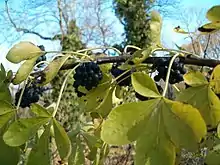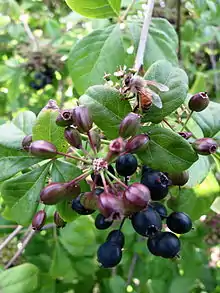Eleutherococcus
Eleutherococcus is a genus of 38 species[1] of thorny shrubs and trees in the family Araliaceae. They are native to eastern Asia, from southeast Siberia and Japan to the Philippines and Vietnam.[1] 18 species come from China, from central to western parts.[2]
| Eleutherococcus | |
|---|---|
 | |
| Eleutherococcus gracilistylus | |
| Scientific classification | |
| Kingdom: | Plantae |
| Clade: | Tracheophytes |
| Clade: | Angiosperms |
| Clade: | Eudicots |
| Clade: | Asterids |
| Order: | Apiales |
| Family: | Araliaceae |
| Subfamily: | Aralioideae |
| Genus: | Eleutherococcus Maxim. |
| Synonyms | |
Perhaps the best known in the West is the species E. senticosus used as herbal medicine,[3] and commonly known by such English names as Eleuthero or Siberian ginseng.[3] In Traditional Chinese medicine, this is administered to increase energy, thus traditionally recognized to have attributes akin to true ginseng (Panax). This is also reflected in its formerly used genus name Acanthopanax[4] meaning "thorny ginseng". The word "Eleutherococcus," from Greek, means "free-berried."
The European Medicines Agency has concluded that there is insufficient evidence to demonstrate the efficacy of Eleutherococcus for any clinical condition.[5]
Naming
The Chinese materia medica in question [3](Chinese: 五加皮; pinyin: wǔjiāpí; Wade–Giles: wuchiapi) may designate a number of species.[6] But the plant now given the common name wujia in China is specifically E. gracilistylus, and according to one source, the genuine crude drug must come from this species, and C. spinosum is only a substitute.[3]
The Japanese name ukogi (ウコギ, 五加(木)) borrows directly from the Chinese name, and refers somewhat broadly to several plants in the genus.[7] A 10th century herbology text, Honzō wamyō (本草和名), introduced the Chinese wujia as an herb to be pronounced mu-ko-gi (牟古岐), refers specifically to E. sieboldianus (Japanese name: hime-ukogi).[8] (See #Species list below).
The taxonomical nomenclature in the botanical science also has had a sinuous history, so that Acanthopanax had been used as the proper genus name in China till recent years, while the West adopted Eleutherococcus as the official name.[3]
Several species are also grown as ornamental garden shrubs. In Japan, they have been planted as hedges.[7] Particularly in Yamagata Prefecture, a daimyō named Uesugi Yōzan[9] encouraged the planting of the ukogi as fencing around the homes of samurai retainers (E. sieboldianus was planted in the region[9]), and the bitter young buds, leaves and stems have traditionally been picked and eaten as vegetable in the area. However, since the plant is deciduous, it requires sweeping in the fall (high maintenance), and the bare hedges fail to protect the homeowner's privacy.
Fossil record
The four earliest fossil species of Eleutherococcus are from the Maastrichtian (about 70 Ma) floras of Eisleben and Walbeck, Germany, the synonym Acanthopanax is used for these species †A. friedrichii, †A. gigantocarpus, †A. mansfeldensis and †A. obliquocostatus.[10]
Species

- Eleutherococcus baoxinensis
- Eleutherococcus brachypus
- Eleutherococcus cissifolius
- Eleutherococcus cuspidatus
- Eleutherococcus divaricatus, Ja:keyama-ukogi (ケヤマウコギ), aka oni-ukogi. Found in central and southern Japan, Korean peninsula, and Chinese mainland, with many flowers arranged in conical inflorescence[11]
- Eleutherococcus eleutheristylus
- Eleutherococcus giraldii
- Eleutherococcus gracilistylus
- Eleutherococcus henryi
- Eleutherococcus higoensis, Ja:higo-ukogi (ヒゴウコギ)
- Eleutherococcus huangshanensis
- Eleutherococcus hypoleucus, Ja:urajiro-ukogi (ウラジロウコギ), growing in limestone soils in Honshu, Shikoku, Kyushu[12]
- Eleutherococcus japonicus, Ja:oka-ukogi (オカウコギ, "land~"), aka tsukushi-ukogi, maruba-ukogi. Grows in hilly terrain, of Kanto, Tokai, Kii Peninsula.[13]
- Eleutherococcus lasiogyne
- Eleutherococcus leucorrhizus
- Eleutherococcus nanpingensis
- Eleutherococcus nikaianus, Ja:urage-ukogi (ウラゲウコギ), variety found in Honshu, Shikoku, Kyushu with yellow-green flowers and blackish-purple fruits.[14]
- Eleutherococcus nodiflorus
- Eleutherococcus pilosulus
- Eleutherococcus pseudosetulosus
- Eleutherococcus pubescens
- Eleutherococcus rehderianus
- Eleutherococcus rufinervis
- Eleutherococcus scandens
- Eleutherococcus senticosus (Rupr. & Maxim.) Maxim., ezo-ukogi (エゾウコギ), species found in Hokkaido, with many white flowers in globular clusters;[3][15][16]
- Eleutherococcus seoulensis
- Eleutherococcus sessiliflorus
- Eleutherococcus setchuensis
- Eleutherococcus setulosus
- Eleutherococcus sieboldianus (Makino) Koidz., Ja:hime-ukogi (ヒメウコギ), native to China's mainland.[17]
- Eleutherococcus simonii
- Eleutherococcus spinosus (L. f.) S.Y. Hu, Ja:yama-ukogi (ヤマウコギ), growing widely in Honshu and Shikoku, with white flowers in globular inflorescence[18]
- Eleutherococcus stenophyllus
- Eleutherococcus trichodon, Ja:miyama-ukogi (ミヤマウコギ), found widely in Honshu and Shikoku[19]
- Eleutherococcus trifoliatus (L. f.) S.Y. Hu
- Eleutherococcus verticillatus
- Eleutherococcus wardii
- Eleutherococcus wilsonii
- Eleutherococcus xizangensis
Formerly under Acanthopanax
- Various Eleutherococcus spp.
- Acanthopanax ricinifolium → Kalopanax septemlobus (Harigiri (ハリギリ, 刺楸))[20]
- Eleutherococcus sciadophylloides, koshiabura (コシアブラ) → Chengiopanax sciadophylloides
References
- Tumiłowicz & Banaszczak 2006,p.40, citing Frodin, Govaerts 2003
- Tumiłowicz & Banaszczak 2006,p.40, citing Xiang, Lowry 2006
- Foster & Yue 1992,Herbal Emissaries pages=73-
- Agricultural Society of Japan 1896p.9 Acanthopanax spinosum, Miq., Ukogi (ウコギ, 五加)
- Committee on Herbal Medicinal Products (2008). "Reflection Paper on the Adaptogenic Concept". European Medicines Agency.
None of the studies would be sufficient to substantiate efficacy of Eleutherococcus preparations in a clearly defined clinical condition
Missing or empty|url=(help) - Nanba, Tsuneo (難波恒雄) (1970). 漢方薬入門(Kanpōyaku nyūmon). Hoikusha.CS1 maint: ref=harv (link), p.41
- (日本國語大辞典), 1976, snippet quote:"果実は熟すと黑くなる,多く生垣に用い,若葉は食用とし、根の皮は五加皮(ごかひ)といい,滋養強壮剤として用いる。"
- Yoshikawa & Ōbori 2002; retrieved from ja:ウコギ属 version 2009年8月23日 (日) 13:10 R.Lucy (accessed April-2012)
- Ogata 2010(website)
- The Timetree of Life edited by S. Blair Hedges and Sudhir Kumar, OUP Oxford, 23. apr. 2009 - 576 pages, ISBN 0191560154, 9780191560156
- 京都府レッドデータブック(Kyoto Prefecture Red Data Book) (2009). ケヤマウコギ(オニウコギ) (in Japanese). Retrieved August 23, 2009.
- 愛媛県レッドデータブック(Ehime Prefecture Red Data Book) (2009). 高等植物 - ウラジロウコギ (in Japanese). Retrieved August 23, 2009.
- 鎌倉発 旬の花. オカウコギ (in Japanese). Retrieved August 23, 2009.
- 神戸・六甲山系の森林. ウラゲウコギ (in Japanese). Archived from the original on November 29, 2007. Retrieved August 23, 2009.
- NAGY 植物図鑑. エゾウコギ (in Japanese). Archived from the original on July 26, 2009. Retrieved August 23, 2009.
- "Eleutherococcus senticosus". Germplasm Resources Information Network (GRIN). Agricultural Research Service (ARS), United States Department of Agriculture (USDA). Retrieved January 12, 2018.
- NAGY 植物図鑑. ヒメウコギ (in Japanese). Archived from the original on July 26, 2009. Retrieved August 23, 2009.
- NAGY 植物図鑑. ヤマウコギ (in Japanese). Archived from the original on July 26, 2009. Retrieved August 23, 2009.
- 日本の植物たち. ミヤマウコギ (in Japanese). Retrieved August 23, 2009.
- Agricultural Society of Japan 1896, p.545 Acanthopanax ricinifolium, Sieb. & Zacc., Harigiri (ハリギリ, 刺楸)
External links
- Dai Nihon Nōkai (author alias) (1896). Useful plants of Japan: described and illustrated (google). 1. Agricultural Society of Japan. p. 9.CS1 maint: ref=harv (link)
- Foster, Steven; Yue, Chongxi (1992), Herbal Emissaries: bringing Chinese herbs to the West : a guide to gardening (preview), Inner Traditions / Bear & Co., p. 73, ISBN 9780892813490
- Yoshikawa, Seiji(吉川誠次); Ōhori, Yasuyoshi(大堀恭良) (2002). 日本・食の歴史地図(Nihon & Shoku no rekishi chizu) (snippet). Seikatsujin shinsho (生活人新書). pp. 175–182. ISBN 4-14-088-016-3.CS1 maint: ref=harv (link)
- Ogata, Takeaki(尾形 健明) (2010). "健康食材としての「うこぎ」の魅力(Appeal of uogi as health food item)". Department of Biochemical Engineering, Yamagata University. Retrieved September 11, 2016.CS1 maint: ref=harv (link)
- Tumiłowicz, Jerzy; Banaszczak, Piotr (2006), "Woody species of Araliaceae at the Rogów Arboretum" (PDF), Rocznik Dendrologiczny, 54: 35–50, archived from the original (PDF) on 2016-03-04